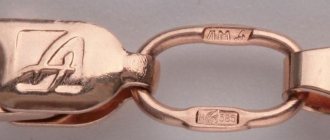Manufacturing of jewelry tags and labels.
Now we offer a new way of applying product information: printing directly on the tag .
Tags are produced in rolls
for subsequent printing on them using a thermal transfer printer.
Unlike the previously used method of printing on labels, which then had to be glued onto tags. As a result, double work was actually done.
Tagging of jewelry taking into account the requirements of the law on GIIS DMDK
The rules for the sale of certain types of goods, approved by Decree of the Government of the Russian Federation of January 19, 1998 No. 55, establish that jewelry and other products made of precious metals and (or) precious stones put up for sale must necessarily have sealed labels indicating:
- name of the product and its manufacturer - type of precious metal - article number - sample - weight - type and characteristics of inserts
Methods for applying information to jewelry tags have also been established. A typographic font with a height of at least 1.2 mm is used, and the details are filled in with the mentioned font or manually with a ballpoint pen with black or blue ink.
It is allowed to put the name of the details and fill them in with a printing device, and the meaning of such details as “name of insert material”, “Month, year of manufacture”, “QC stamp” is affixed with a rubber stamp.
Industry standard No. 117-3-002-95 “Jewelry made of precious metals. General technical conditions", approved. The USSR Ministry of Instrumentation dated July 1, 1988 established that product labels must be made of white thick paper. The thickness of the paper should prevent the possibility of tearing the hole and arbitrary tearing of the label from the product.
In addition, it was determined that labels on products must be attached with threads and sealed. The seal must have a clear imprint of the manufacturer.
Thus, the tags are attached to the products by the manufacturer and sealed with a special seal, the integrity of which guarantees the buyer the absence of counterfeiting and the characteristics of the jewelry declared by the manufacturer.
The store, after checking the weight of the product for compliance with that indicated on the manufacturer’s label, can only additionally attach its own label to the product, but it has no right to spoil or distort the tag with which the product left the production walls.
Taking into account the requirements of the law on GIIS DMDK, the UIN in graphical (in the form of a DM code) and digital representation will have to be present on the jewelry tag. Next to the DM code there should be a link to the FFP website, where you can check information about the jewelry according to the UIN. For balances produced before 07/01/2021, the identification code will be printed on a separate tag. For new manufactured products with markings, it is allowed to print the DM code, UIN and a link to the FPP resource on one tag along with the characteristics of the product.
The need to print an additional DM code (and along with it, a 16-digit number and a link to a website for consumers to check information about the product) for manufacturers means additional time and material costs for marking products.
The new tag, hung on a separate thread, almost doubles the operation time. Placing a DM code, a digital code and a link to a website within a tag already used by the manufacturer seems extremely difficult. In most cases, jewelry tags are already overloaded with information in order to comply with OST 117-3-002-95. There may simply not be enough space for additional information.
There are 2 working options left:
1 - Print 2 tags at a time.
2 — Changing the size of the tag, for example, printing on a tag that folds like a book.
It is necessary to think through options now, then there may simply be no time left, taking into account the possible replacement of equipment and (or) ordering tags of a different format.
Preprint
You can purchase tags made with or without a preprint.
Non-preprinted tags are just white labels. They are sold in any quantity.
In the vast majority of cases, preprint tags are used, i.e. applying your logo, any pattern or texture to them using special equipment.
What is jewelry marking
Marking involves applying two-dimensional DataMatrix codes to gold, palladium and platinum products, which are read by a scanner and contain complete information about the product and about each stage within the cycle of transition from manufacturer to retail owner.
The introduction of labeling is intended to protect buyers from falsification and fraud. The state is striving to get rid of the shadow market and unscrupulous entrepreneurship - both in the field of selling synthetic counterfeits and smuggling, and in terms of inflating the cost of sold jewelry. Labeling also allows full access to information and thereby simplifies the work of supervisory authorities.
Predefined fields
Your drawing may contain predefined fields.
Labels for jewelry
Tags for jewelry are made of cardboard or plastic and have a shaped hole for vertical placement of goods on brackets. The surface of the label can be used to attach goods to it using holes and cutting. It is also easy to attach products to the label using ropes, plastic holders or tapes.
For small tags, separate price tags for the product are used, which are produced on a self-adhesive paper base and are glued to the surface of the tag. Jewelry without precious metals can be presented not in a horizontal display, but in a vertical one, which is convenient when placing a large amount of goods on stands in a store for customers to choose independently. In this case, the tag is also a holder for the product.
In the form of a book
Tags can be in the form of a book.
How and when to label leftover jewelry
For jewelry leftovers released before mandatory labeling began, special rules apply.
- Until January 15, 2022, wholesalers, stores and other market participants must enter into the GIIS information on the balances of precious metals, stones and finished products as of January 1, 2022.
- Before April 1, 2022, you need to re-take the inventory and enter current information taking into account goods sold from January 1 to March 31.
- From September 1, 2022, all “jewelry” declared as surplus must have marking codes. From March 1, 2023, the sale of jewelry is possible only with tags. Industry participants will have a year to engrave all remnants.
- From March 1, 2024, products without a nanomark can neither be sold nor kept on balance sheet.
"Astral.EDO" is a new service for electronic document management. Suitable for working with information systems, including interaction with GIIS DMDK. , and our specialist will contact you.
Tag material
Tags may be cardboard.
Or they may be synthetic. Such tags do not tear and are more resistant to external influences.
Synthetic tags can be bent and folded. In this case, there will be no traces of bending left on them.
It is also worth paying attention to the correspondence of the tag, printer and ink ribbon (ribbon) so that the applied information does not smear or fade.
Barcode
Now you will learn about how to read jewelry tags. Many people prefer to ignore them because the information there is presented very densely and always using incomprehensible symbols. Let's figure it out.
First of all, we pay attention to the quality of the tag itself. It should be made of high-quality synthetic materials, with an industrially punched eyelet and an attached thread with a seal. The imprint of the information must be very clear, even small details down to the dot must be clearly visible, because even dots play a big role in marking stones. The first thing that catches your eye is the barcode. Its presence is mandatory, this means that the jewelry is sold legally and is included in Rosreestr. This applies mainly to large gemstones of natural origin. No barcode - no product. Never buy it, even if the seller makes ironclad arguments about quality and brand.
How to wash, rinse and dry a blanket without a washing machine: complete instructions
French scientists decided to experiment with people in a cave due to coronavirus
For the benefit of descendants: 7 changes that have happened in Crimea over the past 7 years
Making a template
For handmade clothes, jewelry boxes, and toys, you need budget but original labels. They are made independently using the following materials:
- cardboard and paper;
- glue and brush;
- scissors;
- varnish and stain;
- set for fastening blocks.
The work takes place in one of the editors, for example, Microsoft Word. In a new document, you need to open the Inserts tab and select the appropriate shape, rotate it in the desired direction and set the size. Then text is inserted into the shape and adjusted by choosing a font and size. The tag must be double sided, so the first side is copied. It is better to change the text to the inscription “Handmade” or write good wishes to the buyer.
The labels are printed, the paper is covered with a layer of stain or shaded with tea, coffee, or food coloring. The tags must dry, after which they are cut out and pasted onto the cardboard, cutting it along the contours. Then the back of the business card is glued to the other side of the cardboard. They put pressure on it, otherwise the tag will curl in the corners. Even labels are covered with a layer of varnish on both sides , and blocks are attached to them. The finished product is hung on a ribbon from the item.










